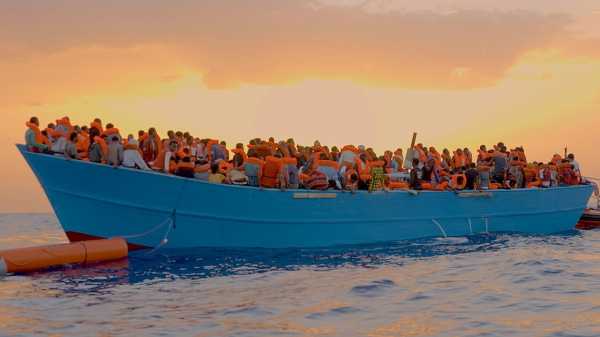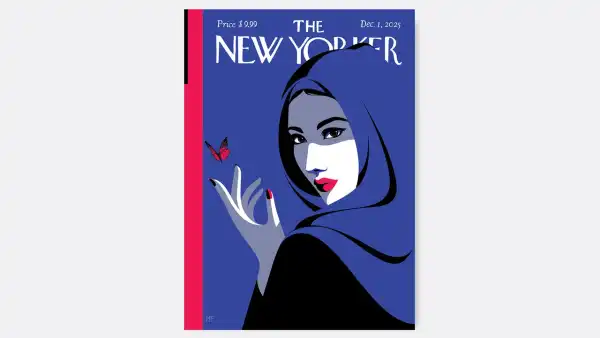
Though its subject matter is rescue missions, Skye Fitzgerald’s short documentary “Lifeboat” has a patient pace and an emphasis on the sensory.
Six minutes into Skye Fitzgerald’s half-hour documentary “Lifeboat,” Jon Castle, the soft-spoken captain of a boat that rescues North African migrants attempting to make it across the Mediterranean, leans over a nautical map. He has glasses, a white-blond beard, and a single earring. He speaks slowly, with a northern-English accent. “Here is the border, Tunisia over here, Libya over here,” he says, gesturing. “We’ve got a beach here, Sabratha—that’s where all the boats have been coming from.” Sabratha, an ancient port city in Libya, is the site of a prison, and of vast human trafficking and misery. The film was shot in 2016, when Castle and his team, volunteers with the German nonprofit Sea-Watch, ventured out for two weeks at a time, rescuing migrants and ferrying them to E.U. transport vessels, then returning to port to refuel and swap out crew members. “These search-and-rescue operations are really triage work—the stakes are life or death,” Fitzgerald told me. “The psychological and physical stress is heavy.” “Lifeboat” captures, up close, the experience of motoring out, encountering vessels packed with migrants, distributing life jackets, helping migrants aboard, and providing them with medical care, water, and space to rest before transferring them to boats bound for Europe. Once you see it, you won’t forget it.
The film begins with grim footage of volunteers on North African beaches, in dust masks, collecting dead bodies. The sound of the wind in the mikes is loud. We transition to daylight—an overhead shot of the stunningly beautiful waters of the Mediterranean, accompanied by the sound of newscasts reporting on people crossing from North Africa to Europe, dying by the hundreds. Then we’re on Castle’s boat. “Lifeboat” has no explanatory voice-overs; Fitzgerald and his team are not an obvious part of the narrative. The focus is on the visual, the pacing slow and patient. The voyage toward Libyan waters is calm, placid; the water is aqua green. Fitzgerald wanted to “allow the ocean to be present in the moment, where sometimes you see the swaying of the waves, sometimes you just hear the wind,” he said. “This is what the asylum seekers are experiencing. This is what they’re hearing.”
Our first sight of a migrant boat is astonishing. It’s a pontoon-style vessel, packed with young men with close-cropped hair, lined up in tightly packed rows, their legs dangling into the water. On that trip, the crew encounters three migrant boats—one wood, two inflatable, all packed. You wonder how they can stay afloat. Once the migrants come aboard, Fitzgerald’s camera lingers on their faces, many of them sleeping, some of them crying. Most of what we’re told about the crisis comes from the words of the migrants, a few title cards, and the news reports at the beginning. Nadine, from Cameroon, says, in French, that they were in jail in Libya because they were kidnapped, and sold, boys and girls, to Malians. “And then we do prostitution there,” she says. “They beat us every day. They even beat the children.” Aisha, from Côte d’Ivoire, says, “They call our parents for ransom money. If we don’t pay, we are imprisoned. Kidnappings, rape, human beings being sold. When I saw this in Libya I couldn’t stand it. Then someone told us about the crossing of the sea.”
“Lifeboat” is Fitzgerald’s second film in a planned trilogy, made with the same all-volunteer team. The first, “50 Feet from Syria,” focusses on a Syrian-American doctor, Hisham Bismar, who volunteers his services to victims of the Syrian civil war. In each film, Fitzgerald and his crew embed long enough to get a vivid closeup of the situation at hand but briefly enough that they can do it on a limited budget. The result is a visceral experience of suffering and the efforts to alleviate it—efforts that feel both inspiring and like a drop in the bucket. Fitzgerald chooses to focus on the inspiration. “Sea-Watch is a group of volunteers who heard that people were drowning off the coast of Libya, and instead of just sitting around twiddling their thumbs, they purchased a retrofitted research vessel, motored down off the coast of Africa, and started pulling people out of the sea,” he told me. “That shows how a civil society can intervene when our nation states aren’t—when someone ought to be doing something.”
Fitzgerald, forty-eight, grew up in rural eastern Oregon. He spent his entire adolescence living in rustic conditions, without electricity or running water. (His parents did this by choice, starting when he was thirteen, an experience he called “initially traumatic.”) “When I went to college and I turned on the hot water for the first time, I just remember this moment of awe—Wow, I turn this knob and hot water comes out,” he said. “I live a very modern life, but I think my upbringing instilled in me an appreciation for what we have in developed nations. I feel a deep affinity for people who find themselves born in countries where they don’t have hot water, or they don’t have a concrete floor.” In college and grad school, at the University of Oregon, Fitzgerald intended to become a theatre director; somewhat by chance, he took a television-directing class and “fell in love with directing for the rectangle.” He now works full time as a director of photography for television documentaries. He funded “Lifeboat” with two small grants and his own credit cards.
“Lifeboat” has been shortlisted for an Oscar, which Fitzgerald hopes increases its visibility, and, perhaps, our empathy for refugees. “The obvious parallel here is closer to home,” he said. “Tear gas was recently used on children legitimately seeking asylum at our own border. We all have to keep working to insure that asylum seekers all over the world are treated with dignity and respect, and afforded the fundamental right to flee oppression and persecution, and seek a safe and prosperous life.” Since the completion of “Lifeboat,” the rise of the far right in Europe has dramatically altered the landscape for migrants and for organizations like Sea-Watch—just as the rise of the far right in the United States has intensified the North American humanitarian crisis for migrants. Fitzgerald has yet to choose a subject for the final film in his trilogy, but options continue to present themselves.
Sourse: newyorker.com






